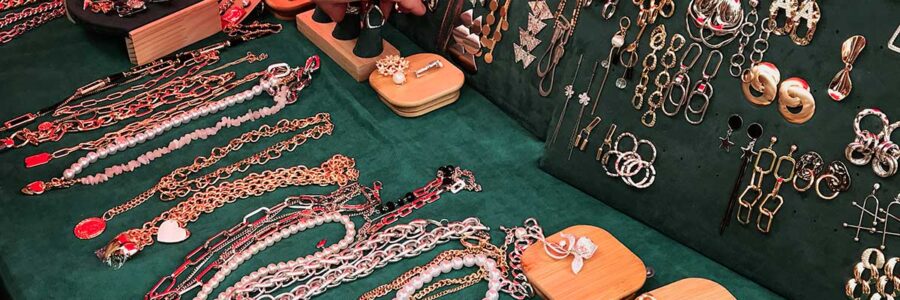Costume jewelry is a fun and affordable way to accessorize, but there’s a darker side to those bright earrings and sparkly bracelets. Many pieces of inexpensive jewelry contain toxic chemicals that can pose serious health risks, especially for children.
In a study conducted by the Ecology Center, over 50% of the costume jewelry tested from popular retailers like Walmart and Target contained hazardous materials such as lead, cadmium, chromium, and nickel. These heavy metals are often used in producing low-cost jewelry, but their impact on health can be severe.[1]
What Harmful Chemicals Are Hiding in Your Jewelry?
Many people are unaware of the toxic substances that could be in their jewelry. Here are some of the most concerning:
- Lead: Lead is toxic at any level, and its use in children’s products has been restricted for good reason. However, it’s still found in some costume jewelry, posing a risk of brain damage, learning disabilities, and developmental issues in children. In adults, prolonged exposure to lead can cause kidney damage and reproductive problems.[2]
- Cadmium: This carcinogenic metal is often used in low-quality jewelry. Cadmium can accumulate in the body, damaging kidneys and weakening bones. Children are particularly at risk due to their higher absorption rates.[3]
- Chromium: Frequently used to give jewelry a shiny finish, chromium can cause allergic skin reactions and irritation. In higher amounts or over extended exposure, it can also affect respiratory health.[4]
- Nickel: Nickel allergies are extremely common, and contact with nickel can cause red, itchy rashes. Nickel exposure is especially problematic for children because they may not realize what’s causing the reaction.[5]
These harmful materials can cause a range of health issues, from mild skin irritation to more severe, long-term problems like cancer and organ damage. Parents should be especially aware of these risks, as children are more likely to chew on jewelry or put it in their mouths.
Health Concerns for All Ages
Children are particularly vulnerable to the toxic chemicals found in costume jewelry, but adults aren’t immune to the risks. Wearing jewelry made with harmful materials can lead to skin reactions, respiratory problems, and even long-term exposure to carcinogens. Regular contact with toxic metals through jewelry can have a cumulative effect over time.
The risk is even greater for children, who tend to put jewelry in their mouths or accidentally swallow small pieces. This increases the likelihood of ingesting harmful substances like lead or cadmium, which can lead to developmental delays and other health complications.
How to Choose Non-Toxic Jewelry
The good news is that safe, non-toxic alternatives are available. Here are a few ways you can protect yourself and your family when shopping for jewelry:
- Look for High-Quality Materials: Sterling silver, gold, platinum, and titanium are safe options that are unlikely to contain harmful chemicals and are also less likely to cause allergic reactions.
- Consider Natural Alternatives: Jewelry made from wood, bone, or natural fibers can be a stylish and safe choice. Just make sure the materials are untreated or finished with non-toxic coatings.
- Certifications Matter: Look for brands that test their products for harmful chemicals. Certifications like REACH Compliance or OEKO-TEX Standard 100 indicate that the jewelry is safe to wear.
- Avoid Coatings and Plated Jewelry: Many cheap jewelry items are plated with nickel or other toxic metals. Instead, choose solid metals or be cautious of plated pieces, as they’re more likely to contain harmful substances.
- Test at Home: You can purchase affordable lead or nickel testing kits to check your jewelry’s safety. These kits provide a simple way to ensure your accessories are free from toxic materials.
Protecting Your Health
Choosing safe jewelry is more than just aesthetics—it’s about protecting your health. By avoiding cheap, toxic materials and opting for high-quality, natural alternatives, you can minimize your exposure to harmful substances.
Taking the time to research and select non-toxic jewelry is an investment in your well-being. After all, the jewelry you wear should be as safe as the food you eat and the products you use in your home. Prioritize safety without sacrificing style by making informed choices about the accessories you bring into your life.
References:
- Castillo, Michelle. Costume Jewelry Found to Have High Levels of Toxins and Carcinogens, Tests Show – CBS News. 15 Mar. 2012, https://www.cbsnews.com/news/costume-jewelry-found-to-have-high-levels-of-toxins-and-carcinogens-tests-show/.
- Wani, Ab Latif, et al. “Lead Toxicity: A Review.” Interdisciplinary Toxicology, vol. 8, no. 2, June 2015, pp. 55–64. PubMed Central.
- Genchi, Giuseppe, et al. “The Effects of Cadmium Toxicity.” International Journal of Environmental Research and Public Health, vol. 17, no. 11, June 2020, p. 3782. PubMed Central.
- Sharma, Pooja, et al. “Health Hazards of Hexavalent Chromium (Cr (VI)) and Its Microbial Reduction.” Bioengineered, vol. 13, no. 3, pp. 4923–38. PubMed Central.
- Murphy, Patrick B., et al. “Allergic Contact Dermatitis.” StatPearls, StatPearls Publishing, 2024. PubMed.


